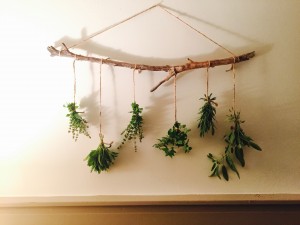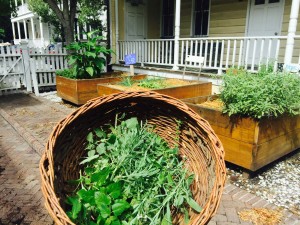Beginning this past May, I have been lucky enough to intern for the Restorative Agriculture Program through the Grounds Department here at the College of Charleston. The main goal of this program is to maintain our four on-campus gardens using sustainable techniques in the downtown urban environment. We also run the on-campus compost system located at 45 Coming Street. My specific role this semester is to not only maintain the gardens, but to be in charge of our social media. As the social media intern, one of my responsibilities is to promote our events and then post photos of them. Our most recent event was the Halloween Herbalism Workshop.
One of our on-campus gardens is designated as an herbal medicinal garden, containing sage, rosemary, lavender, lemon basil, lemon balm, and borage. These herbs were used in our Herbalism Workshop. As students, faculty, and community members were sipping on sage, lavender, rosemary tea made right there, my boss, Lexa Keane, went through a detailed slideshow about various herbal remedies and the importance of herbal medicine opposed to scientific medicine. We learned that the “wise-woman”, or herbal, method is more proactive and nourishing than scientific methods. We were also taught about what specific herbs can be used for. A lot of herbs have many functions and can act as: carminatives, which aid digestion; anti-inflammatorys, which help inflammation; circulatory stimulants, which get the blood flowing; emmenagogues, which promote menstrual cycles; astringents, which clears or dries things out; adaptogens, which aid the immune system; nervines, which tone and repair the nervous system; and bitters, which enhance digestion. For example, ginger is an anti-inflammatory as well as a circulatory stimulant and an emmenagogue. The different types of herbal remedies that were discussed included: infusions, which are made from leaves, water, oil, and alcohol; tinctures, which are concentrated liquids extracted from the herb; salves, which are made with infused herbal oil, beewax, and essential oil (note however, that essential oil is not sustainable, yet all of the other practices and ingredients are); decoctions, which are made from roots, bark, seeds, and can be used in teas; syrups, which are a mix of sweetener and a decoction; elixirs, which can help with long term issues; poulstices, which contain chopped herb mixed with boiling water to create a pulp; and finally compresses, which help injuries, fevers, and headaches. For a cold or the flu, an infusion would be the best remedy, yet for a liver issue, a decoction would work best.
The lesson on herbal practices was followed by the opportunity to create your own teabag or smudge stick (used to burn as incense) using the herbs harvested from our herbal medicinal garden! We harvested the herbs weeks prior and hung them around our office so that they would dry in time for this event. There was a pretty large turn-out, which I was pleasantly surprised by. People seemed to really enjoy the lecture and then were able to apply that information to make their very own tea. The workshop accomplished so much: teaching the community about sustainable practices specifically with herbs, and bringing the community together to enjoy the herbs they walk past each and every day! Overall, I think the workshop went better than expected and I am excited for our next event- the Kimchi Workshop. Interning with the Restorative Agriculture Program has taught me so much about sustainable techniques that are so easy to apply to everyday life. I would say that my lifestyle has definitely changed for the better as I continue to become more knowledgeable about urban farming and restorative agriculture practices. Feel free to “like” our Facebook Page: College of Charleston Restorative Agriculture Department, and follow our Instagram account: cofcrestorativeag.




